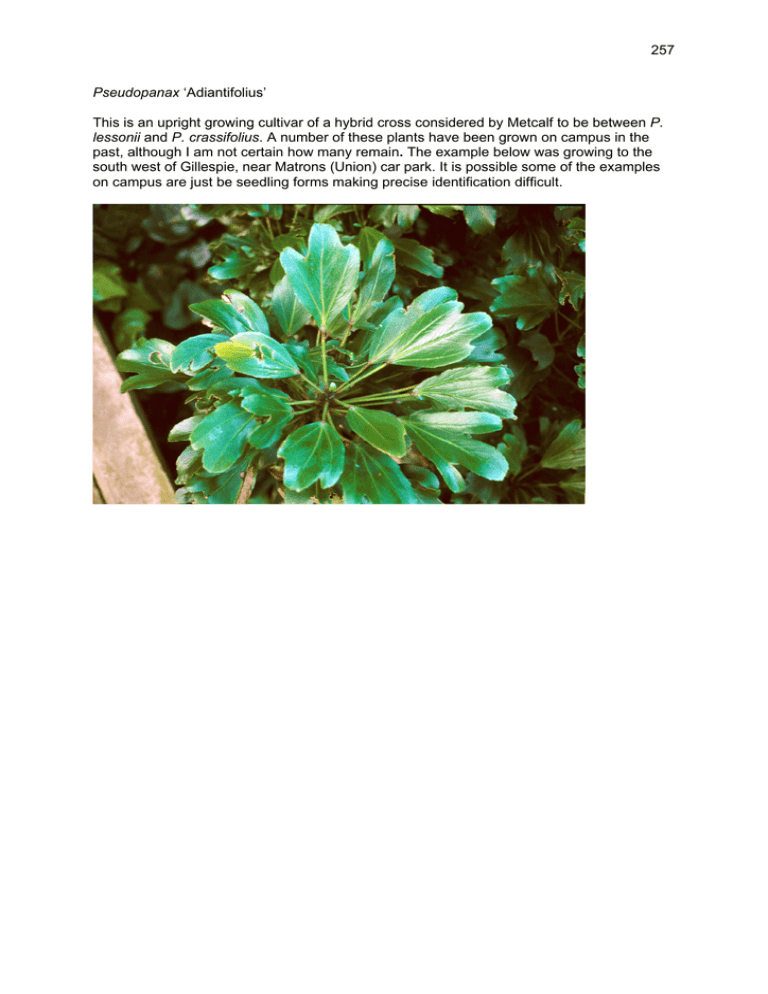257 P. .
advertisement

257 Pseudopanax ‘Adiantifolius’ This is an upright growing cultivar of a hybrid cross considered by Metcalf to be between P. lessonii and P. crassifolius. A number of these plants have been grown on campus in the past, although I am not certain how many remain. The example below was growing to the south west of Gillespie, near Matrons (Union) car park. It is possible some of the examples on campus are just be seedling forms making precise identification difficult. 258 Pseudopanax arboreus (whauwhaupaku, five finger) Pseudopanax arboreus is growing in a number of sites on campus. There are examples at the western end of the Horticultural Teaching lab, on the south side of Farm Road opposite where the old McCaskill Building was, in the Amenity area and so on. Pseudopanax arboreus is a large rounded shrub or small tree with large dull dark green pinnately compound leaves. It is often seen with compound umbels carrying young flower buds or old berries. Example on south side of Farm Road Palmately compound leaves, alternately arranged, leaflets serrated, petiolules and petioles often purplish, note dark compound umbels with a few florets opening. 259 Pseudopanax crassifolius (horeka, lancewood) Pseudopanax crassifolius is a very distinctive small tree in the New Zealand landscape. It has some very distinctive stages of growth from the juvenile form with its long leathery leaves which droop to gradual changes to the adult form where the leaves are much shorter and tend to ascend the top of a single or multi-branched specimen. The late John Taylor. (Previously a senior lecturer in Amenity Horticulture and Urban Parks the Department of Horticulture during its growth years in the 1970’s and 1980’s. pictured with a young lancewood. Adult lancewood at the south west corner of Orchard car park. 260 Pseudopanax ‘Cyril Watson’ This example is growing at the south western boundary of Orchard car park. It is similar in some respects to Pseudopanax ‘Adiantifolius’, but not as erect. It is about 3m in height with a similar spread. This is an evergreen New Zealand native shrub Leaves simple, deeply 3 lobed at apex, alternately arranged, thick and leathery. This specimen is in the southern most border of Orchard car park centre - western end. 261 Pseudopanax discolor There are many examples of this species on campus, against the north and south walls of the Field Services Centre buildings, south west of Lincoln Ventures, south of the walkway at the Natural Resources Engineering Buildings and so on. The example below is on the north side is just to the west of the entrance to the FSC colours up to a bronze or purplish green in the winter, the example on the south side is a yellowish green. Both examples are about 23m in height with a spread of slightly less. Both examples were probably planted in the late 1980’s. This example is near the north entrance to Field Service Centre. Leaves palmately compound, become purplish in sun during winter particularly. 262 Pseudopanax ferox (fierce lancewood, toothed lancewood) Pseudopanax ferox looks similar to lancewood Pseudopanax crassifolius except that it is generally smaller and has very sharply toothed leaves, particularly in the juvenile stages of growth. This species also goes through a number of growth forms to end like one of Dr. Seuss’s lollipop trees. There are a number of examples on campus, on Farm Road opposite where McCaskill Building was, south of the Nursery on Farm Road, at the Amenity area etc. Juvenile growth form, fiercely toothed descending leaves Developing into the adult growth form where terminal leaves are shortening and beginning to ascend. Adult form, this example is on the south side of the Nursery on Farm Road. 263 Pseudopanax laetus This is a hardy evergreen shrub or small rounded tree. It is sometimes confused with P. arboreus. The leaflets of Pseudopanax laetus are however serrate in the upper half only, whilst those of P. arboreus are completely serrated. There are many examples of this species on campus including south of Gillespie, west of Lincoln Ventures, in the New Zealand plants collection in the Amenity area and so on. Leaves large, palmately compound, alternately arranged Compound umbels of flowers in mid spring North of Matron’s car park 264 Pseudopanax lessonii (houpara) This species is an upright growing shrub or small tree to 4m or so in height. It is less hardy than most of the other Pseudopanax mentioned in this guide and has often been planted against the walls of buildings. There is an example of this species growing against the west facing wall of the Horticultural Teaching lab just north of the walkway to the Winery. Other examples are south of Gillespie and in the southern bed of Orchard car park. There is also an example of Pseudopanax lessonii ‘Gold Splash’ growing on the western side of the pond in the Amenity area. This example is against the Horticultural Teaching lab. Palmately compound leaves, alternately arranged and berries (early June) 265 Pseudopanax lessonii ‘Gold Splash’ Pseudopanax lessonii ‘Gold Splash’ in the Amenity area. Leaves are palmately lobed, alternately arranged, leaflets 3-5, sessile on long petioles. Note some reversion occurring, this should be removed to retain the variegated sport. 266 Pseudopanax ‘Linearifolius’ There is an example of this evergreen New Zealand native shrub growing on the west side of the path as you head south from Gillespie Hall to Matron’s car park. This is considered by Metcalf to be a cultivar of hybrid origin, probably P. lessonii and possibly P. crassifolius. It is an erect growing shrub that has been fairly slow growing in this site to a height of 2m or more. An old specimen on the south west corner of the native plants garden south of Gillespie. Palmately compound leaves, leaflets 3- mainly 5, oblanceolate, sessile on long petioles. 267 Pseudopanax simplex I am not certain that this is Pseudopanax simplex, but cannot imagine what else it may be. This is an evergreen shrub that is against the small brick structure on Farm Road at the south west corner of the New Zealand native plants garden south of Gillespie Hall. This shrub has simple oblanceolate to occasionally elliptic leaves arranged alternately, but occasionally opposite, the upper half to two thirds of the leaf is coarsely serrate, the remainder entire. The stem and parts of the petiole and lower portion of the midrib are marked red-purple. This shrub has an erect habit of growth and is around 2-3 metres in height. An erect growing shrub south west of Gillespie Hall Leaves simple, alternate or opposite, oblanceolate to elliptic, serrate, petiolate. 268 Punica granatum (pomegranate) There is only one example of pomegranate on campus that I am aware of, the other example on the north side of the Works office in Farm Road was a victim of a tidy up operation by the Grounds Department. Both examples have been part of the campus for forty years or more. The remaining example is in the old Formal Garden to the east of the Library. This species is deciduous and has some slight value in terms of autumn colour, but is mainly grown for its attractive scarlet fruits. This example is near the south side of the pergola in the old Formal Garden. Leaves are simple, opposite, oblong, glossy.





